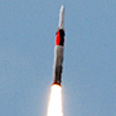
US to help Israel develop Arrow-3
Head of US Missile Defense Agency to recommend to Congress that America finance development of modern version of anti-ballistic missile system
This professional recommendation will help US Defense Secretary Robert Gates receive the Congress' approval to help develop Arrow-3. Gates made such a promise to Defense Minister Ehud Barak during the latter's visit in Washington about a week ago.
The Arrow-3 system, an advanced model of an Arrow interception missile, is slated to help Israel intercept ballistic missiles in a much wider range than the range reached by Arrow-2 missiles, which are now being operationally used as part of the Israel Air Force's antiaircraft lineup.
The new missile, which is in its initial development stages in an Israel Aerospace Industries (IAI) factory, should also be able to intercept ballistic missiles in heights of more than 100 kilometers (i.e. outside the atmosphere).
These performances of the new missile, along with an improved radar system, are expected to provide the Israeli missile interception lineup with many more opportunities to hit a ballistic missile or its warhead during its flight using a number of interception missiles, and reducing the danger of having the warhead and remnants of the ballistic missile land on Israeli territory after being successfully intercepted.
The need for the Arrow-3 missile has become crucial in light of the progress made in the Iranian nuclear program. According to estimates, it would be possible to place first operational Arrow-3 batteries within three years, should the development carry on with no budgetary and technological delays.
The program's cost is estimated at some $700-800 million over three years. Israel has asked the United States to include the Arrow-3 development in the annual funding granted by the US Congress and government to the Arrow program.
Every year, the US gives Israel some $140 million to help fund the Arrow program. The US finances 80% of the anti-ballistic missile system's production and development, and Israel pays the rest of the sum.
The missiles are manufactured in cooperation between the Boeing company factories (sub-contractor) and an IAI factory.
New player threatens to thwart funding
There seemingly was no reason for the US not to continue providing financial aid for the development and manufacturing of the Arrow-3, as it helped finance previous plans. However, when Israel announced it plans to develop a long-range missile interception system, a new player entered the scene.
American company Raytheon suggested that instead of financing the Israeli development, the US Congress and government fund the development of its Standard Missile 3 (SM-3).
Like the Israeli missile, the American project is also slated to be based on an existing missile. But unlike the Arrow, which is placed on land and is only aimed at intercepting ballistic missiles, the SM-3 is used by the US Navy and is aimed at intercepting aircraft, ships and missiles threatening warships.
Raytheon claims that if the missile undergoes certain changes, it would be possible to place it on land and use it to successfully intercept ballistic missiles.
Israel objected to the development of the SM-3 at the expense of the US funding of the new Arrow program, as the Defense Ministry prefers to provide work to Israeli industries and because the cost of the new Standard is estimated at $10-12 million per missile, while the Arrow-3 will only cost 1.5-2 million per unit. Another reason is that the Arrow missiles have already been successfully tested as an anti-ballistic missile system.
The Arrow-3 technology is only an improvement of an existing and proven ability, while the SM-3 still requires technological changes and improvements which will adjust it to the interception of ballistic missiles from the land.
Defense establishment officials were worried that the Americans might prefer to finance a missile produced by their own military industries rather than develop an Israeli interception missile.
The Israeli fears were slightly eased this week. An American technical team which recently examined the Arrow-3 plans and the head of the US Missile Defense Agency were convinced that the development of the Arrow-3 should be favored and that Israel should receive the required funding as part of the aid plan.
The program will be under American supervision, and should it turn out that the development is being delayed or is failing to reach its objectives, the resources will be shifted to the development of the SM-3.










